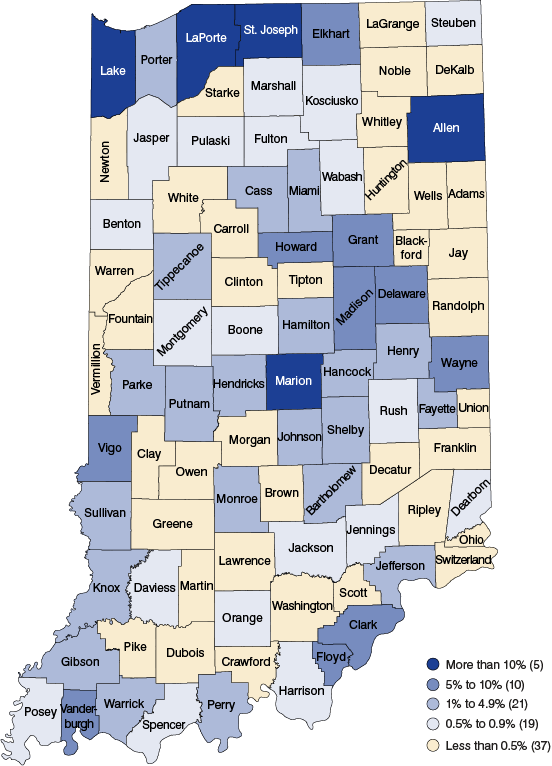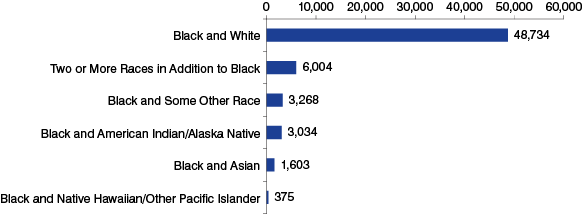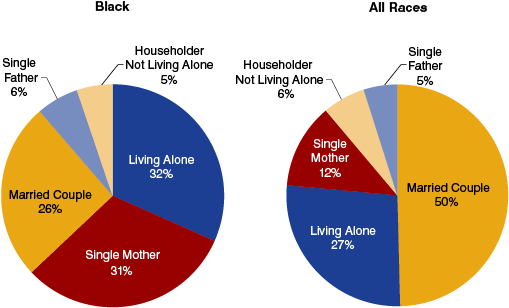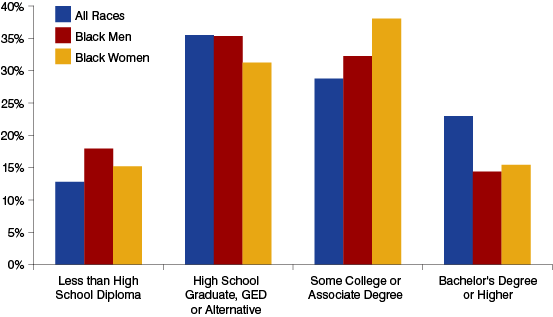Exploring Hoosier Minority Groups: Indiana's Black Population
Indiana’s population has become increasingly diverse in terms of race and origin. Results from the latest census count for 2010 provide us with a rich set of information from which to gain insight into our population diversity. This article will be the first of four InContext articles to provide demographic snapshots of our minority population. As the state’s largest minority group, blacks or African Americans comprised 9.1 percent of Indiana’s population in 2010 and will be the focus of our first snapshot. The overview that follows focuses on population, household formation, income and education.
Population
591,397 Hoosiers reported black as their only race (“black alone” in Census Bureau lingo) in 2010. While every Indiana county includes some black residents, 62 percent of the state’s black population resides in just two counties—Marion and Lake. Within these two counties, blacks comprise more than 25 percent of the total population (see Figure 1).
Figure 1: Blacks as a Percent of Total Population, 2010

Source: IBRC, using Census 2010 data
All statistics in this article are for the black alone population, but it is worth noting that an additional 63,018 Hoosiers report having some black ancestry in combination with another race (see Figure 2). While the black alone population makes up 9.1 percent of Indiana’s total population, those who specified their race as black alone or black in combination with another race account for 10.1 percent of the total population.
Figure 2: Indiana Multiracial Population Reporting Race as Black in Combination with Another Race, 2010

Source: IBRC, using Census 2010 data
Since 2000, Indiana’s black population has grown by 16 percent—an increase of 81,363 people. This increase was seen across the state (in fact, 20 counties saw their black population more than double), and only 13 of the state’s 92 counties saw declines in their black population.
In addition, the black population is younger than the state’s population overall (see Figure 3). The median age for blacks is 30.7 years, compared to 37.1 for the overall population.
Figure 3: Indiana Age Distribution, 2010

Source: IBRC, using Census 2010 data
Households
Census 2010 reports 220,246 black households in the state. (When it comes to race at the household level, the household is characterized based on the race of the primary householder.) Those living alone comprise 32 percent of all black households followed by “female householders with no husband present.” For the sake of convenience, we refer to these as single mothers; however, one must keep in mind that this does not necessarily mean there are no other adults in the household and it can include cohabiting couples.1 Meanwhile, just over a quarter of black households are comprised of married couples—significantly less than the overall proportion of 50 percent for the state as a whole (see Figure 4).
Figure 4: Indiana Households by Type, 2010

Note: The single-mother category is “female householder, no husband present” and the single-father category is “male householder, no wife present.”
Source: IBRC, using Census 2010 data
58 percent of the black population lives in rented units, relative to 28 percent of the total population (see Table 1).
Table 1: Indiana Homeownership, 2010
| Indicator | Black | All Races |
|---|---|---|
| Owned with a mortgage or a loan | 36% | 57% |
| Owned free and clear | 7% | 16% |
| Renter occupied | 58% | 28% |
Note: These percentages are based on the population in occupied housing units.
Source: IBRC, using Census 2010 data
Income and Educational Attainment
Since Census 2010 did not collect any economic data, we must turn to the 2011 American Community Survey (ACS) for this information. Per capita income in 2011 was $16,501 for Indiana’s black population, compared to $23,524 for the overall population. Meanwhile, the median household income for Indiana’s black households was $28,485—nearly $18,000 less than the median for all households in the state ($46,438).
The Indiana black poverty rate was 34 percent according to the ACS, compared to 16 percent for the overall population.
Figure 5 shows educational attainment for the black population broken down by gender. It is worth noting that while a lower percentage of Indiana’s black population has a bachelor’s degree or higher, 54 percent of black women have either some college experience or a college degree—a number on par with women of all races.
Figure 5: Indiana’s Adult Educational Attainment, 2011

Note: Educational attainment statistics are calculated for those age 25 and older.
Source: IBRC, using American Community Survey data
Learn More
To access more data about Indiana’s black population, visit American FactFinder from the U.S. Census Bureau at https://data.census.gov, which contains data from both Census 2010 and the latest American Community Survey.
Notes
- Data for specific races are unavailable, but for all races combined, 20 percent of Indiana’s single-mother households and 48 percent of single-father households include an unmarried partner. See Rachel Justis, “Where Are the Kids? Indiana Households with Children,” InContext, September-October 2011, www.incontext.indiana.edu/2011/sept-oct/article2.asp.
